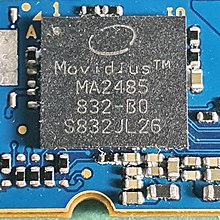This article has multiple issues. Please help improve it or discuss these issues on the talk page. (Learn how and when to remove these messages)
|
| [REDACTED] | |
| Company type | Private |
|---|---|
| Founded | 2005; 20 years ago (2005) |
| Defunct | September 2016; 8 years ago (2016-09) |
| Fate | Acquired by Intel |
| Headquarters | San Mateo, California, U.S. |
| Products | Computer vision and deep-learning processor chips |
| Owner | Intel |
| Website | www |
Movidius Ltd. was a company based in San Mateo, California, that designed low-power processor chips for computer vision. The company was acquired by Intel in September 2016, who continues to sell the company's products under the Movidius line.
Company history
Movidius was co-founded in 2005 by Sean Mitchell and David Moloney in Dublin, Ireland. Between 2006 and 2016, it raised nearly $90 million in capital funding. In May 2013, the company appointed Remi El-Ouazzane as CEO. In January 2016, the company announced a partnership with Google. Movidius has been active in Google's Project Tango, and in September 2016 it was announced that Intel planned to acquire the company.
Products

Myriad 2
The company's Myriad 2 chip is a manycore vision processing unit that can function on power-constrained devices. The Fathom is a USB stick containing a Myriad 2 processor, allowing a vision accelerator to be added to devices using ARM processors including PCs, drones, robots, IoT devices and video surveillance for tasks such as identifying people or objects. It can run at between 80 and 150 GFLOPS on 1W of power.
Myriad X
Intel's Myriad X VPU (vision processing unit) is the third generation VPU from Movidius. It uses a Neural Compute Engine, a dedicated hardware accelerator—for neural network deep-learning inferences.
Neural Compute Stick
| This section contains promotional content. Please help improve it by removing promotional language and inappropriate external links, and by adding encyclopedic text written from a neutral point of view. (May 2023) (Learn how and when to remove this message) |
 Intel NCS2 PCB front
Intel NCS2 PCB front Intel NCS2 PCB back
Intel NCS2 PCB back
The Intel Movidius Neural Compute Stick (NCS) is a compact device designed to facilitate the development of deep learning applications at the network edge. It utilizes the Intel Movidius Myriad 2 Vision Processing Unit (VPU), which is also found in various smart devices like security cameras, gesture-controlled drones, and industrial machine vision systems. The NCS supports frameworks such as TensorFlow and Caffe for developing neural network models.
The second iteration, the Intel Neural Compute Stick 2 (NCS 2), was introduced on November 14, 2018, at the AI DevCon event in Beijing. This version is based on the Myriad X VPU, which significantly improves performance over the original, providing up to eight times the processing capability for AI inference tasks. The NCS 2 is designed to work seamlessly with the Intel Distribution of OpenVINO toolkit, which helps developers optimize and deploy their models efficiently.
The NCS connects to a host machine via a USB interface, allowing developers to rapidly prototype and deploy deep neural network applications without the need for cloud connectivity. This makes it suitable for various real-time, low-power applications where efficient on-device processing is essential.
Uses
- Google Clips camera uses Myriad 2 VPU.
- The Intel RealSense Tracking Camera T265 uses the Myriad 2.
- In 2016, Mavic incorporated the Myriad 2 VPU in all its consumer drones.
- The Ryze Tello affordable programmable drone, licensing Mavic Software, uses the Myriad 2 VPU.
- ComBox Technology uses Myriad X in ComBox x64 PCIe Blad board for CNN inference in DC.
See also
References
- Staff, Fora. "Movidius founder after €300m sale to Intel: 'Losing control of the company is difficult'". TheJournal.ie. Retrieved 2022-03-30.
- Newenham, Pamela. "Sean Mitchell and David Moloney, Movidius". The Irish Times. Retrieved 15 March 2016.
- "There are 100 jobs coming at this cutting-edge Irish company". Thejournal.ie. Retrieved 15 March 2016.
- "After Moore's law | Technology Quarterly". The Economist.
- "Movidius Raises $16 Million to Boost Augmented Reality Portfolios". SiliconAngle. July 10, 2013. Retrieved 4 August 2016.
- Weckler, Adrian. "Dublin tech firm Movidius to power Google's new virtual reality headset". Independent.ie. Retrieved 15 March 2016.
- Popper, Ben (2016-03-16). "The chipmaker behind Google's project Tango is powering DJI's autonomous drone". The Verge. Retrieved 2017-07-22.
- "Movidius + Intel = Vision for the Future of Autonomous Devices | Machine Vision Technology | Movidius".
- "Deep Learning On A Stick: Movidius' 'Fathom' Neural Compute Stick (Updated)". Tom's Hardware. 2016-04-28. Retrieved 2016-05-28.
- ^ Vincent, James (2017-10-06). "Google's Clips camera is powered by a tailor-made AI chip". The Verge. Retrieved 2020-11-25.
- ^ "Movidius Supplies Myriad 2 Vision Processing Unit for Newest DJI Drone, the Mavic Pro". Retrieved 2020-12-28.
- "Robust Visual-Inertial Tracking with Tracking Camera T265". Intel RealSense Depth and Tracking Cameras. Retrieved 2020-11-25.
- "Cool New Tello Toy Drone Soars into CES 2018". Retrieved 2020-12-28.
- OpenCL compute devices
- Technology companies based in the San Francisco Bay Area
- Companies based in San Mateo, California
- Technology companies established in 2005
- Intel acquisitions
- 2016 mergers and acquisitions
- Defunct computer companies of the United States
- Defunct computer hardware companies
- Defunct semiconductor companies of the United States